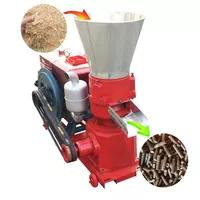What is a granulator?
A granulator (additionally known as a granulator, granulator) is a mill or machine used to form powder materials into granules. A pellet mill usually consists of a pellet die and a drum. A rotating roll or rotating die forces the feedstock through the die holes to form particles. (See pictures of ways pelletizers produce pellets).
The Role of the Granulator
Biomass from plants may be used to provide alternative fuels to fossil fuels without any process. However, low densities of natural biomass, i.e. 80-150 kg/m3 for herbaceous biomass and 150-200 kg/m3 for woody biomass, limit their application in energy production. These materials then want to be densified to increase bulk density.
What is using Wood Pellets?
As I said, maximum pellet machines on the market are designed to make fuel pellets, in particular wood pellets. wood pellet mill are a dense biomass fuel that may be used as an opportunity for fossil fuels. Wood pellets are focused biomass cylinders made of wood chips, shavings, sawdust and different forestry by-products, typically 6mm or 8mm in diameter and no more than 40mm in common length. Condensed wood pellets generally have low moisture content, excessive calorific value, and excessive combustion efficiency, making them widely used worldwide.
The History of Pellet Mills
There are generally styles of granulators, one is known as flat die granulator and the opposite is called ring die granulator. I’ll communicate more about this later. The first granulator changed into advanced in the early 1900s based on a flat plate die. In the beginning, farmers used flat die pelletizers to pellet feed. With the improvement of technology, flat die granulators changed into advanced to produce fuel pellets as an alternative to fossil fuels to deal with the energy crisis.
How does a Granulator Work?
Generally speaking, taking biomass pellet machines as an example, raw material densification involves 3 stages. In the primary stage, the particles rearrange to form tightly packed masses without changing their properties too much, and energy is dissipated because of inter-particle and particle-to-wall friction. In the intermediate stage, the particles squeeze every different and go through plastic and elastic deformation, which significantly will increase the inner particle contact. In the very last stage, the density of the fuel pellets will increase significantly because of the high-pressure casting of the pellet machine.
Classification of Granulators
The classification of pellet generators can range in keeping with unique criteria.
According to the mechanical running principle, the granulator may be divided into ring die granulator and flat die granulator. A ring dies granulator presses the feed distributed at the inner surface of a rotating die in the front of every roll into grooves through the die holes to shape granules. The flat die granulator may be further divided into types, one is a curler pushed kind with a hard and fast die, and the opposite is a die rotary kind with a fixed roller.
Pelletizer Market Status
The growing call for wood pellets in the international market has driven the growth of the pellet machine market. The EU’s 2020 coverage targeting renewable energy and greenhouse fuel online discount has driven giant growth in the wood pellets market. It is needed that through 2020, 20% of total energy consumption will come from renewable energy. Looking back at the latest years, in 2009 about 650 pellet mills in Europe produced the most effective 10 million lots of pellets. But the modern global market demand for biomass pellets is around 16 million lots in 12 months and will triple to 46 million lots in 12 months through 2020, implying a complete market price of $8 billion (€5.75 billion). Most of the near-time period growth in the global wood fuel pellets market is expected.




